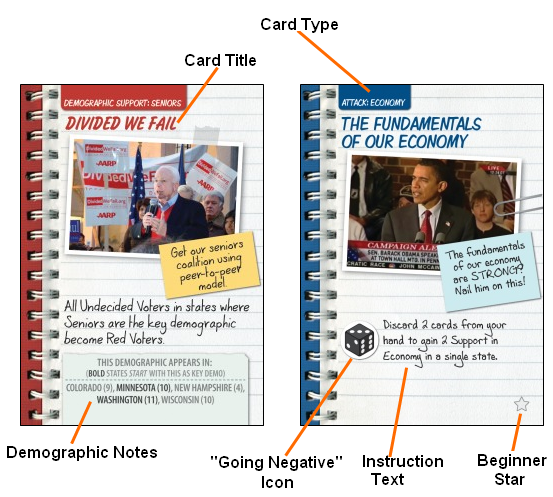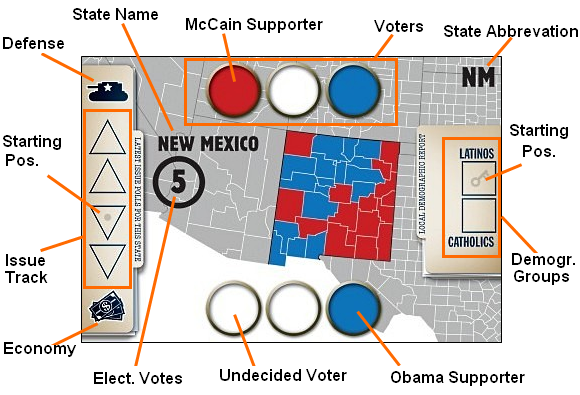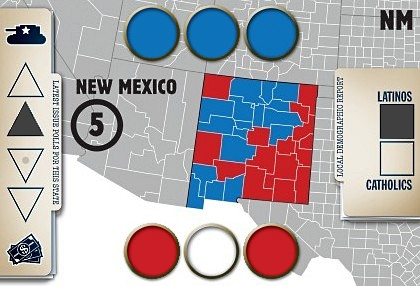External links:
Introduction
A modern U.S. presidential campaign is one of the most amazing organizational endeavors
undertaken by man. In 2008, John McCain and Barack Obama collectively
spent $2.4 billion dollars on their efforts to be elected President of the United
States. That is more money than the federal government devoted to the Manhattan
Project. It is a larger figure than the gross domestic product of 32 countries.
You could purchase three 50-story skyscrapers for the same amount. So, when we talk
about running a U.S. presidential campaign, we are really referring to something
akin to running a Fortune 500 company. The most remarkable thing is, a campaign
manager must take this enterprise from literally nothing to these enormous heights
in about a year’s time.
It’s a grueling job, with enormous pressure and a lot to juggle. You have the candidate,
the media, volunteers in every state, the campaign staff, the internet, attack ads,
campaign consultants, pollsters, proxies and political problems of every conceivable
stripe.
And at the end of the day, what is your reward? If you win, you get the problems
of governance. If you lose, you earn your party’s scorn and the inevitable finger-pointing
that follows.
In Campaign Manager 2008, we invite you to undertake this thankless task
by assuming the role of the campaign manager for either Barack Obama or John McCain.
Your candidate is relying on you to develop a campaign strategy and then go on to
manage this enormous endeavor successfully. You will consider a variety of different
tactics and strategies available to you, crafting a personal campaign plan by selecting
a unique combination of techniques aimed squarely at pummeling your opponent...
...of course, that’s just what your opponent intends to do to YOU.
Components
- 2 sets of 45 Campaign Strategy cards (red: McCain, blue: Obama)
- 1 deck of 20 Breaking News event cards
- 20 Battleground State tiles
- 2 sets of 12 Support markers (red: McCain, blue: Obama)
- 1 "Going Negative" die
- 1 "Going Negative" results chart
- 1 scoring track
- 20 scoring tiles (red/blue)
- 4 Issue markers
- 4 Key Demographic markers
Anatomy of the Campaign Strategy cards:

Anatomy of a state

Each Battleground State tile represents a specific state and indicates the number
of electoral votes (victory points) which will go to the player who wins
that state. At any given time, there will be 4 states in play; as each is won, it
is replaced by another until all have been brought into play or someone has won
the game.
Each state features two rows of colored circles which run along the top and bottom
of the card, representing blocks of Voters. The color of the Voters indicates
which candidate they currently support, with red circles being supporters of McCain,
blue circles being Obama supporters, and white circles being Undecided Voters.
The row at the top of the card (adjacent to the Defense symbol) reflects the opinions
of voters in the state if they have decided that Defense is the most important
issue in the election. The row at the bottom (adjacent to the Economy symbol) reflects
their opinions if they have decided instead that Economy is most important.
This sentiment is indicated by the four-space Issue Track which runs along
the left side of the card. An Issue marker is moved up and down the track as the
leaning of the state’s electorate shifts, and it is swiveled to match the outline
of the track space it occupies. Whichever issue (Defense or Economy) a state’s Issue
marker points to is termed the current majority issue in that state,
and the other is termed the minority issue.
Each state also has two demographic groups. At any given moment, one of these
two will be marked with a Key Demographic marker to indicate that it is currently
the key demographic in that state. The current key demographic in a state
may be targeted to win over that state’s Undecided Voters. The other demographic
group has no effect.
Getting started
1) Build your Campaign decks
While each player has a supply of 45 Campaign Strategy cards, only 15 of these will
be used in any individual game. The first step, therefore, is for each player to
select the 15 cards which will make up his own Campaign Deck for the current game.
This is done through a drafting process as described below.
For a player’s first game of Campaign Manager, it is recommended to use the preconstructed
decks which have been designed to introduce novice players to the game. These cards
are identified with a small star icon. This will give players an opportunity to
learn the relative strengths of the different types of cards before diving into the
deck-building process. Players may feel free to ignore this recommendation and dive
straight in, however, if they prefer!
Each player shuffles his 45 cards, then draws and secretly examines 3 of them.
Of these 3 cards, he must select one to keep and set the other two aside face-down,
out of the game. The player then repeats this process of drawing 3 cards at a time,
keeping one and setting the remainder aside, until he has gone through all 45 of
his cards. The 15 cards each player chooses to keep will make up his Campaign Deck
for the current game; the 30 he sets aside will not be used and may be returned
to the game box. Once both players have built 15-card Campaign Decks in this manner,
they should shuffle their decks face-down and draw a 3-card starting hand
with which they will begin the game. Players keep their hands hidden from each other
during the game.
2) Choose your starting states
Next, each player takes the 10 state tiles with his color and logo on the back,
and privately selects two of them to be in play at the beginning of the game. When
both players are ready, the four chosen states are revealed and placed face-up between
the players; the rest may be set aside until needed later. Place the Issue markers
and Key Demographic markers in the indicated starting positions on each state.
When playing with the preconstructed starting decks, new players should select the
four starting states identified with a small star icon: Florida, Michigan, Missouri,
and New Jersey.
3) Shuffle the Breaking News deck
Shuffle the Breaking News event cards and place them face-down near the states
in play to form a deck. (Cards will be drawn from this deck and resolved as new
states enter play.)
Playing the game
The first player to finish building his Campaign Strategy deck may go first.
When playing with the preconstructed starting decks, the player closest to his 18th
birthday (his date of voter eligibility) may go first.
Play alternates between the two players. On his turn, a player must either:
- Play a card from his hand
When a card is played, the instructions on the card are followed. Most cards are
then placed on the player’s discard pile at the end of the turn.
The exceptions to this are Media Support cards, which remain face-up in play
until another Media Support card is played, causing the older card to be replaced
and moved to the owning player’s discard pile.
or
- Draw a card from his deck
If a player already has 5 or more cards in his hand, however, he may not choose
to draw a card (although he may still play cards which grant additional cards).
Apart from this restriction, there is no hand size limit.
Reshuffling
If a player wishes to draw a card but has no cards remaining in his Campaign Deck,
his discard pile is first reshuffled to form a new deck. If this occurs in the midst
of a player’s turn, any cards played earlier on that turn should not be shuffled into
the new deck.
Gaining support
When a card (or event, or Going Negative result) indicates that a player gains a
point of Support in a particular issue in a state, this means one Voter on the side
of the state associated with that issue switches to that player’s color. This can
be accomplished in any of three ways:
- Players may place a token of their own color onto a Voter spot of their
opponent’s color.
- They may remove a token of their opponent’s color from a Voter spot of their
own color.
- They may replace a token of their opponent’s color that’s on a white
spot with a token of their own color.
All of these actions are equivalent, and it doesn’t matter which method players
use – all result in a Voter of their opponent’s color being replaced with one
of their own.
(Note: Players are much less likely to run short of Support markers if they remove
tokens whenever possible rather than adding new ones.)
If the opposing player has no Voters to be taken away, the player may instead place
one of his tokens on an unoccupied white spot (an Undecided Voter). These
Undecided Voter spots will ordinarily be the last Voters claimed unless affected
by a Demographic Support card or a Breaking News event.
Note that once either player has placed a Support marker onto an Undecided Voter
spot, it is no longer an Undecided Voter and will never again become one. While
a token on one of these spots might be replaced by one belonging to the opposing
player, it will never be removed entirely.
If all of the Voters for an issue are already the player’s color, gaining Support
in that issue in the same state has no further effect.
Shifting a state toward an Issue
When a card (or event, or Going Negative result) indicates that a player may shift
a state toward a particular issue, the state’s Issue marker is moved the indicated
number of spaces in the specified direction. If the marker is already in the furthest
track position in that direction, additional shifts in that direction have no further
effect.
The term majority issue refers to the issue (Defense or Economy) that
the Issue marker currently points to; the term minority issue refers to the other
issue.
Altering the Key Demographic in a state
When a card (or event, or Going Negative result) indicates that a player may alter
the key demographic in a state, the state’s Key Demographic marker is shifted
to the other demographic, making it the new key demographic in the state.
The key demographic in a state is significant when Demographic Support cards
are played from a player’s hand. These cards make Undecided Voters in all in-play
states with a particular key demographic give their support to the player.
Note that states where that demographic appears but where it is not the key demographic
are not affected. Furthermore, Undecided Voters who have already given their
support to a candidate are also unaffected.
Discarding cards for effects
Some cards indicate that a player may discard additional cards from their hand to
gain some effect. These cards may not be played without discarding the required number
of cards. Of course, if a card indicates that a player may discard "any number"
of cards, zero is a legal choice. Similarly, a Campaign Strategy card may be played
even though it has no effect, in order to remove the card from your hand and progress
the turn.
"Going Negative"

Some cards feature a large die icon. These cards represent "negative campaigning"
that has a chance of causing a minor backlash against the player. Whenever a player
elects to Go Negative by playing one of these cards, he must roll a die at
the end of his turn and consult the results chart to determine the effect,
in the form of a bonus granted to the opposing player. The opposing player
may then apply the bonus.
|
Result:
|
Bonus:
|

|
Gain 1 Support in either issue in a single state.
|

|
Shift a single state 1 toward either issue.
|

|
Alter the key demographic in a single state.
|

|
Draw a card.
|

|
Draw 2 cards.
|

|
No effect.
|
Winning a state
If at any time all of the Voters on the majority issue side of a state are
in support of a single candidate (i.e., all the Voters on the side currently pointed
at by the Issue marker are either red or blue), that player immediately
wins the state and claims its scoring tile, placing it on his scoring track with
his own color showing.
Claimed scoring tiles are laid out end to end in a row along the scoring track starting
from the far left.
(Note that Obama has two electoral votes pre-printed on his scoring track; the player
representing him should be careful to line up any scoring tiles with these (not
directly against the edge of the track) so as not to "lose credit" for these two
votes.)
Winning a state (along with the accompanying steps described below) occurs
immediately when a player achieves the necessary support, before rolling
the die for Going Negative. If multiple states are won simultaneously, each is resolved
one at a time as described below, in the order desired by the current player.

Example: The Obama player wins New Mexico and claims the 5 Electoral
Votes of that state.
Bringing new states into play
Whenever a player wins a state, that state is removed from play and replaced with
a new state from those which have not yet been brought into the game (all such states
are eligible; the color/logo on the backs is only relevant during starting setup).
The player who won the state chooses which new state will be brought in,
even if it is currently the opposing player’s turn. If all states have already been
brought into play, no further states can be added and the game will continue with
a reduced number of states in play. The Issue and Key Demographic markers from the
old state are placed into the indicated spaces on the new one, and all Support markers
from the old state return to their owners.
Breaking News
Every time a new state is brought into play (not counting the four starting
states), a card is drawn from the Breaking News deck and resolved (by following
its instruction text). By default, this event affects the new state which just entered
the game, unless the effect of a Media Support card dictates otherwise. If
multiple states are being brought into play, an event is drawn and resolved for
each one as it is added, before introducing the next. Once resolved, Breaking News
cards are removed from the game.
It is possible that a Breaking News event might result in additional states being
won by one player or the other. As in any case when multiple states have been won,
the current player may decide the order in which they are resolved.
Winning the game
Each candidate comes into the game with a slightly different number of electoral
votes already "locked up" in non-battleground states. Therefore, each player needs
a slightly different number of additional votes to achieve the 270 electoral votes
necessary to win the election. McCain requires 115 additional votes to win; Obama
needs another 113 votes.
(This perceived advantage is offset by McCain’s entering the game with a slight
edge in battleground states worth a few more total votes than those favoring Obama.)
During the game, players will be filling up their scoring tracks with scoring tiles
as they win states. If a player claims sufficient scoring tiles to extend his collection
far enough to reach or pass the 270 mark, he immediately wins the game!
In the event that the game ends with neither player having reached the necessary
270 votes (i.e., both players have exactly 269 electoral votes), the election is
too close to call. While in real life this would be only the beginning of a long
adventure in recounts and Supreme Court deliberations, for game purposes the players
should consider this rare eventuality a draw.
Credits and acknowledgements
|
Game design:
|
Christian Leonhard & Jason Matthews
|
|
Graphic design:
|
Joshua Cappel
|
|
Publisher:
|
Z-Man Games
|
The authors would like to dedicate this game to the memory of Franz-Benno Delonge,
a wonderful game designer who left us far too soon. Campaign Manager 2008 was inspired
by an unpublished design of his which used a similar two-tracked "support"
mechanism.
Note: Please see original rules for acknowledgements.
The Online game:
- The game window is available in small and large size. You can switch by using the
selection box, but it is only possible at the beginning of your turn. By default
the game window that fits with your current screen resolution is displayed.
Please note that this game has been optimized for a resolution of at least 1280*1024.
If possible you should use that resolution.
- If a player plays a "Going Negative" card, the die is thrown automatically
and the player will see the result after finishing his turn.
- Click on the Info button of the opponent’s display to see his current
discard pile. Please note that this also shows cards that have already been discarded
during the game but are not part of the current pile.
- Hover the mouse over the votes display to see the scoring track.
- It is possible that players (especially non-Americans) do not know all the names,
abbreviations and terms used on the single cards. If you want to know more about
it, please use online resources.